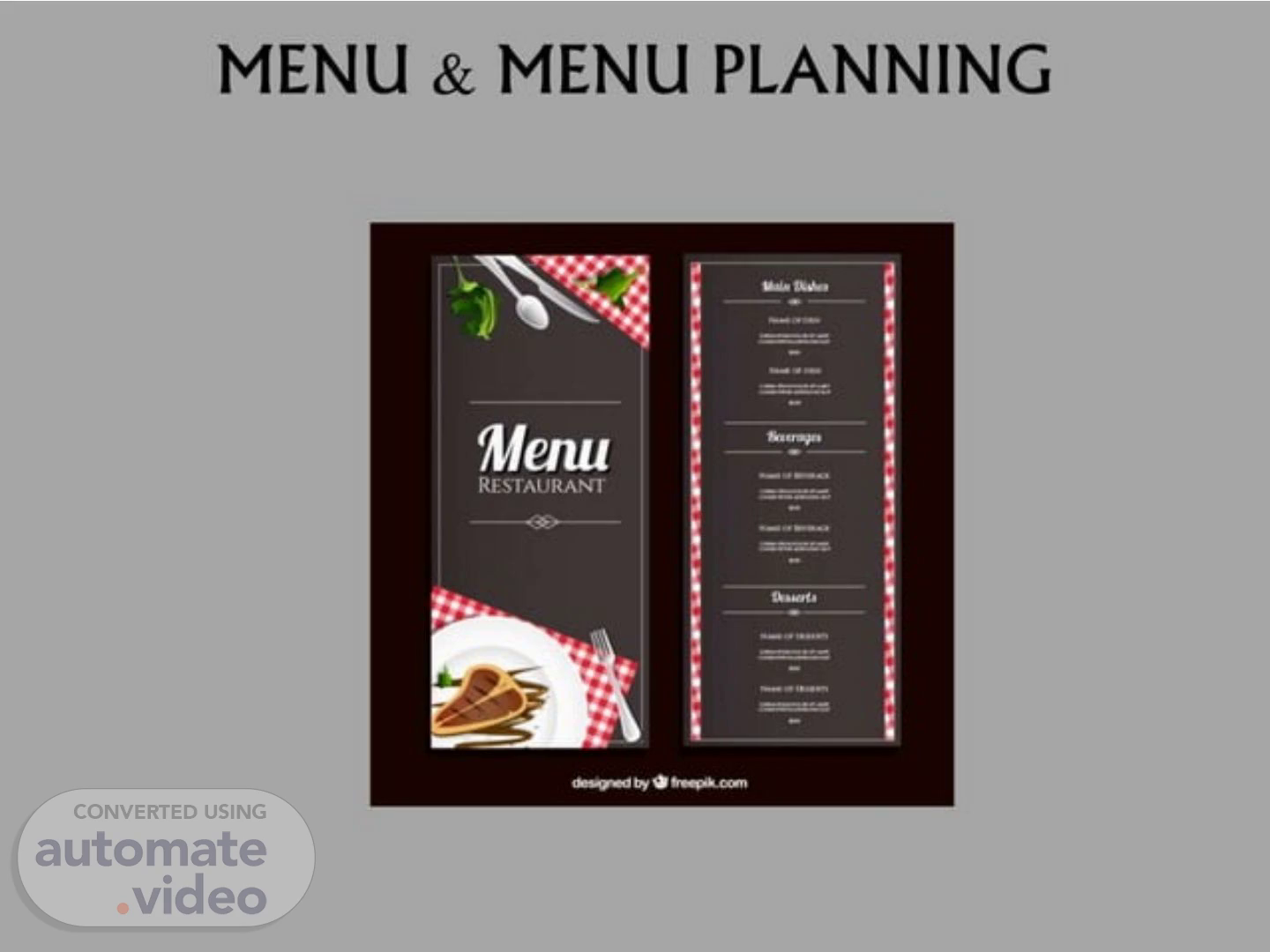
Page 2 (7s)
MENU & MENU PLANNING What is a menu? The menu is a list of food and beverage items that can be offered by a food service outlet. The menu ," like much of the terminology of cuisine, is French in origin. It ultimately derives from Latin "minutus," something made small. The original menus that offered consumers choices were prepared on a small chalkboard, in French a carte; so foods chosen from a bill of fare are described as "å la carte," "according to the board." BREAKFISTS 11" BAPS APPETISERS MN SA'OWKNS SAI-ADS.
Page 17 (2m 14s)
TYPES OF MENU: BY MEAL TIMES 4) BRUNCH MENUS: Menu designed for guests who wish to wake up late in the morning. Brunch is a combination of breakfast and lunch and spread well beyond breakfast timings. MENU & MENU PLANNING Sunday Bruncb IDenu Carving St.riarr.• On the Buffet: • Mini & Drinks autut'ons.• • Cod" • Tea • V 2 Gute • - tty in Beer ball.
Page 19 (2m 39s)
MENU & MENU PLANNING TYPES OF MENU: BY SPECIALITY 1) Poolside menus: Menu designed to provide small dishes in the poolside area. POOL snack sereoice.
Page 22 (3m 4s)
MENU & MENU PLANNING Menu planning: Factors to Consider in Menu Planning Availability of Foods- A menu is primarily based on what can be bought in the market. In fact, this should really be the basis for planning for planning specific dishes. Always consider food in season. Think of available ingredients as substitutes for those off-season. Food Habits of Costumers- Food managers can take a survey in the vicinity where food establishment is located. The survey can consider the culture of the people living in the vicinity (their customs, traditions, religion and etc.) People will patronize a food establishment where their needs and desires, as well as their beliefs and practices are not violated in the food they eat..
Page 23 (3m 33s)
MENU & MENU PLANNING Menu planning: Amount of Money Available- A food establishment has a definite budget intended for food preparation. Control in expenses, by operating within a given budget, allows the food manager to predict cost and, at the same time, predict profit. It is important, however, that expenses incurred in food compensates for the bulk of sale expected or predicted for the day. Amount of Time Available- Food preparations must meet deadlines. Costumers have their own meal schedule to meet. Quick service is one important asset of an ideal establishment. Food ordered should be prepared in the shortest time possible. To realize this, time-saving techniques must be employed by the cooks especially if orders keep coming in..
Page 24 (4m 3s)
MENU & MENU PLANNING Menu planning: Type of Consumers- This refers to the age, sex, occupation, socio-economic status, and nutritional needs of the costumers. For instance, the school canteen where students are the major patrons of the establishment, the canteen manager must offer foods high in carbohydrates and protein since most of the students are growing kids. Environmental Conditions- Here, one thinks of hot summer months and the cold rainy months. Specific dishes offered in food establishments should consider the environmental temperatures. Special hot foods can be offered on cold rainy days and vice versa. Aside from the regular menu of the establishment, will be seasonal offerings in keeping with the conditions of the environment..
Page 25 (4m 32s)
MENU & MENU PLANNING Menu planning: Occasions- special occasions like Christmas, birthdays, anniversaries and etc. require special menus. The manager must prepare a complete list of main dishes, entrees, appetizers, salads and desserts from which patrons will choose from. Types of Business- this includes the kind of food establishment you will have, either luxurious, canteens, coffee shop, cafeteria and the likes. Hours of Business- includes the time of the day that the establishment will be opened. Types of Menu- the type of menu is considered in this factor. It will be either A La Carte, or Du Jour Menu. And the way these foods will be served-buffet, self-service or sit-down..